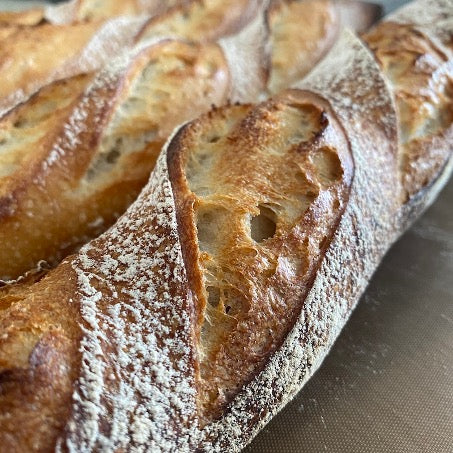When I grew up a baguette, or in Dutch called stokbrood, was a bread baked on special perforated waved baking trays, with a thin slightly gold brown crust, with the soft and tight crumb of a sandwich bread. In our case we ate this mostly while barbequing smothered with garlic butter or peanut sauce. But when I grew older and started working in different bakeries I got in touch with the better baguettes, still made with yeast but the where baked on the ovenfloor to create the crispier crust. With years I learned more and more and discovered that a really nice baguette should be given a lot of time to develop the distinct flavors and ferment in the right way.
I gave it a couple of tries in the beginning when I just started home baking but in the beginning I had a hard time with the fermentation, my starter, at that time, was regularly not matured enough to get things right, so the dough went in the fridge well before it had developed enough. So when shaping and all the dough stayed pretty underproofed. Still baking them because the recipe told me it was time I ended up with very dense and unpleasant baguettes.
I dived into the theory behind the fermentation and gave it couple new tries, one better than the other but learning new things every time. I guess time has come to say I know what I’m doing, the dough turns out great every time, but for now I am focusing on getting the perfect score that gives me the great baguette ears bread after bread.
Ingredients:
- 500 gram T65 breadflour
- 60 gram whole wheat flour
- 375 gram water
- 100 gram strong starter
- 12 gram salt
Method:
Mix the flour, starter and 325 gram of water together until there is no more dry flour visible and let sit for autolyse for one hour. After autolyse add the salt with a splash of water and incorporate to your dough. Mix the dough for around 5 minutes adding a splash of water bit by bit till all the water is incorporated (bassinage) and the dough is medium developed.
Bulkferment the dough for around 3-4 hours with 4 sets of stretch and folds to give the dough strength and the dough begins to show signs of fermentation. Transfer the dough to the fridge for ripening overnight.

Next day the dough should show more signs of fermentation and it has proofed by around one third. Take the dough out of the container and divide into 4 pieces, shape the pieces of dough into balls but be gentle and try to keep as much air in the dough as possible and let rest uncovered for 30 minutes.
After the rest shape the dough gently but firm into baguettes with sharp tips and good tension on the outside. Then proof 1,5-2hrs on a board lined with a couche to hold the shape. Cover the dough with another piece of cloth to keep the dough from developing a crust on the outside.

Preheat the oven to 240-260C with a baking steel inside. When your dough is ready to bake transfer gently to your peel and dust with a bit of ryeflour. Score the dough 3 or 5 times on the topside overlapping by half.
Load the dough into the oven, apply a lot of steam and lower the temp to 240C bake for 15 minutes, let the steam out and bake for another 5-10 minutes until the baguettes are crispy and have a nice color.



1 reactie
So good! Will try…🤞🏼